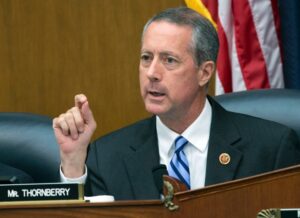Donald Trump Needs A ‘Bigger Stick,’ So Up Defense $: Thornberry
Posted on

Rep. Mac Thornberry
WASHINGTON: The odds keep getting better that Donald Trump will ask for a big boost to defense spending in a supplemental request soon after his inauguration. But who gets how much for what? That raises a whole host of unanswered questions, experts and policymakers made clear today at the Center for Strategic & International Studies.
At CSIS’s annual Global Forum, House Armed Services chairman Rep. Mac Thornberry repeated his recommendation (first made Wednesday) that President-elect Donald Trump send the Republican-controlled Congress a supplemental defense spending request for fiscal 2017 during his first 100 days in office. This plus-up would buy additional planes, ships, and other weapons the House tried to add to this year’s National Defense Authorization Act but which were dropped from the final conference version for lack of funding.
“I would follow Teddy Roosevelt,” Thornberry said, responding to an audience member who asked what signal the new administration could quickly send the world to demonstrate American resolve. “Speak softly and carry a big stick. We need to make our stick bigger.”
The quickest way for Trump to make America’s stick bigger, Thornberry went on, would be to “submit a supplemental request for defense early on to give us a head start at building back some of this capability. That would be the first signal that you need to send. Before you start moving troops around or making more promises, you need to build up a bigger stick.”
Thornberry said the new administration and Congress also should increase the defense budget in fiscal 2018. He also suggested that automatic spending cuts under the Budget Control Act of 2011, known as sequestration, may be on the way out.
“There is a growing perception — on both sides of the aisle, in both houses of Congress — that we’ve cut too much from defense and the Budget Control Act disproportionately damages defense (because) more than half the discretionary budget is defense,” Thornberry said.

Donald Trump has pledged to increase the size of the Army.
Who Gets What?
Given Trump’s estimated $60 billion worth of campaign promises to increase the end-strength of the Army and Marine Corps, buy more ships for the Navy and aircraft for the Air Force, and restore funds lost to the military since 2013 under sequestration, former top Pentagon officials appearing at CSIS seemed to think Thornberry is likely to get his wish not only for a supplemental and future defense budget increases but also an end to sequestration. But some cautioned that fiscal facts could limit the increases, and intra-service struggles over the money are likely.

Leon Panetta
Former defense secretary (and congressman, and Office of Management and Budget director, and CIA director) Leon Panetta said he hoped the new Congress and administration would increase defense spending. But above all, he said, they need to establish stable budgets that allow the Pentagon and services to plan at least five years into the future. “Right now we’re got a Defense Department that has a high ops tempo and, quite frankly, low morale,” he said.
But Panetta added that the fiscal outlook makes the prospects murky. “We’ve got a $20 trillion debt,” he said. “We’re going to have a $1 trillion deficit. We’re on an unsustainable path. If he (Trump) doesn’t deal with these issues, I don’t care what the president’s priorities are, he won’t have the resources to deal with it. Are we going to borrow $1 trillion for infrastructure? Are we going to do a tax cut that’s going to add trillions to the debt as well?”
During a subsequent panel, CSIS moderator Andrew Hunter asked panelists to comment on how defense budget increases might play out. “If you raise the top line, where does that money go?” Hunter asked. “How is it divvied up among the services? How is it divvied up among the priorities of personnel, force shaping and readiness? And there’s obviously going to be some competition for those resources.”
William Lynn, CEO of European aerospace company Leonardo and deputy secretary of defense in the Clinton administration, said that while Trump will “probably make good” on his campaign promises to increase defense spending, “I don’t think it’s going to be quite as easy and maybe not quite as large as people are anticipating at this point.”
Lynn predicted that the “biggest competition” for whatever new funding emerges “will be inside the Army.”

Heidi Shyu
“(Trump’s) strongest commitment is to increase the size of the Army,” Lynn said, and “that is a very expensive option to pursue. It’s very possible that you will add more demands for resources with an increase to the structure than you will actually add dollars to the Army budget.” Adding military personnel (MILPERS) funds for the new troops’ pay and benefits is not enough: You also need to buy their equipment and pay for maintenance and training, or else they’re expensive idle hands.
Heidi Shyu, who stepped down in November after more than five years as assistant secretary of the Army for acquisition, agreed.
“You’’ve got to remember, the chief’s responsibility is to be ready to fight in any contingency tomorrow,” Shyu said, referring to the Army chief of staff. “He’s going to focus on manpower. He’s going to focus on training. That equals readiness. But as we have already seen with what’s been happening in Ukraine, we need modernization to counter current threats — not future threats, current threats. That’s why I keep harping upon, we’ve got to focus on the modernization.”
Subscribe to our newsletter
Promotions, new products and sales. Directly to your inbox.
